Cite this document
(“The Important Child Skills and the Influencing Environments Essay”, n.d.)
Retrieved from https://studentshare.org/environmental-studies/1412414-human-development-and-learning
Retrieved from https://studentshare.org/environmental-studies/1412414-human-development-and-learning
(The Important Child Skills and the Influencing Environments Essay)
https://studentshare.org/environmental-studies/1412414-human-development-and-learning.
https://studentshare.org/environmental-studies/1412414-human-development-and-learning.
“The Important Child Skills and the Influencing Environments Essay”, n.d. https://studentshare.org/environmental-studies/1412414-human-development-and-learning.


